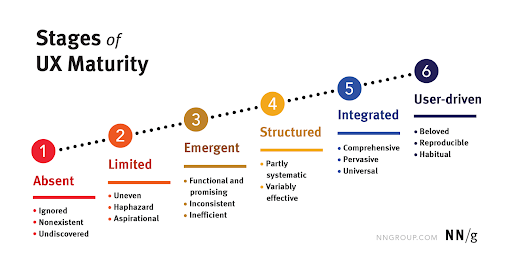Many organizations realize the importance of having a UX presence in their teams.
But UX presence is not the same as UX maturity.
What Is UX Maturity?
UX maturity refers to the level of sophistication, effectiveness, and integration of user experience practices within an organization. It represents how well an organization understands, values, and consistently implements user-centric design principles across its products and services.
Maturity Happens in Stages
UX maturity is not achieved overnight. It requires learning from experiences and integrating feedback. A gradual approach allows organizations to identify and mitigate risks as changes are introduced. In essence, UX maturity happens through a long process of continuous improvement, learning, and adaptation.
According to the NN Group, UX maturity happens in six stages (see image below). Higher maturity indicates a more user-focused and design-driven approach.

Why Is UX Maturity So Important?
Not evolving to an advanced UX maturity level poses significant risks, such as inconsistent user experience, increasing user frustration, and poor adoption. It can also lead to missed opportunities and difficulty adapting to emerging trends, which in turn can diminish your competitive advantage and brand image over time.
The question then is about your current maturity level. Where do you stand in terms of UX maturity?
Let me share the steps we take at QBurst to assess our UX maturity. You can adapt them to suit your organizational setup.
Steps to Assess UX Maturity
- Gather 360-Degree Inputs
Start by interviewing key organizational stakeholders, including product/project managers, designers, developers, and QA. Try to understand their perceptions of the current state of UX in your organization.
In a larger organization, collecting everyone's opinion can be challenging. Form a representative sample of relevant teams and then collect their input.
Once you have 360-degree perspectives, identify areas where your organization excels and where it needs improvement.
This will give you a picture of your organization's UX maturity level.
- Evaluate UX Practices and Strategy
Assess the organization's UX practices. Examine how the organization conducts user research and usability testing, and the extent to which UX design principles are applied in projects.
It is likely that your organization does not follow the entire UX process for all projects. The extent of implementation may be dependent on the context, time, and budget of the project. So look for projects where the UX designer has done extensive user research. Analyze the methodology used and the deliverables.
Analyze any existing documentation or deliverables related to UX practices, such as design systems, research reports, and past user testing results. If there is a dedicated UX team, assess its size, skills, and responsibilities. Evaluate their collaboration with other departments.
From this evaluation, you can understand if your organization has a robust UX process in place and how well it implements the process across products/projects. This will also help you understand critical skill gaps.
- Examine UX Metrics
Does your organization have metrics or Key Performance Indicators (KPIs) related to UX? They can include user satisfaction scores, usability metrics, user analytics, surveys, and any data on the impact of UX improvements on the business.
Remember that no single metric or method can fully capture the UX of a project or product. A combination of these metrics, along with user research and feedback, will provide a more holistic understanding of the user experience. Regularly collecting and analyzing these data points allows you to continually enhance the UX of your products.
At QBurst, we use a mix of behavioral and attitudinal KPIs, which vary according to the vertical.
How to Advance Your UX Maturity?
Once you have gathered the data and evaluated existing practices, develop a plan for advancing your UX practice. This plan should outline specific goals, activities, and timelines for achieving results.
At QBurst, we practice continuous improvement, where we aim to apply the best UX practices not only to the interfaces we build but also to internal processes. Through ongoing assessment and refinement, we make sure that our practices align with user expectations and organizational goals.
Here are a few steps you can take to advance your maturity if you are still in the early stages:
- Sensitize Key Stakeholders
Start with your top management. If they understand the value of UX and its impact on business, then half of the problem is solved. Next are your key clients. Explain to them how a focus on UX can lead to better products. Quantify the return on investment (ROI) of UX improvements to demonstrate the business value of UX.
Spread awareness across all teams. The principles of user-centric design may not be understood uniformly across the organization, which can lead to inconsistent practices and a lack of alignment in decision-making.
- Build a Robust UX Team
Create a dedicated team of UX designers, researchers, and information architects. This team can take the lead in driving UX initiatives and prioritizing user-centered design. They can define and track UX-related KPIs to gauge the impact of design decisions on user experience.
- Ensure UX-Driven Development
Ensure that UX is integrated into every stage of the product development lifecycle. This means involving UX professionals from the concept and research phases through design, testing, and ongoing improvement. The UX team can set usability guidelines for the project team to adhere to before a release.
- Invest in Skill Development
This could include UX workshops or certification programs to build UX expertise across the organization. Stay informed on UX best practices and benchmark your organization against competitors. Share success stories that demonstrate how investing in UX has positively impacted your organization.
- Adopt an Iterative Design Process
Embrace an iterative design process, where products are continually refined based on user feedback and evolving business needs.
Guard Your UX Maturity
As your organization advances through maturity stages, it's crucial to actively prevent regressing to an earlier stage. Various factors such as rapid organizational growth, increasing complexities, overreliance on success metrics, and team complacency can contribute to this potential setback. Stay vigilant to maintain progress.
Make sure there is no dilution of processes and the quality of UX professionals hired is not compromised. A culture of continuous learning and cross-functional collaboration can stave off problems of complacency and silos. A user-centered approach that values both quantitative and qualitative insights should also be prioritized.


